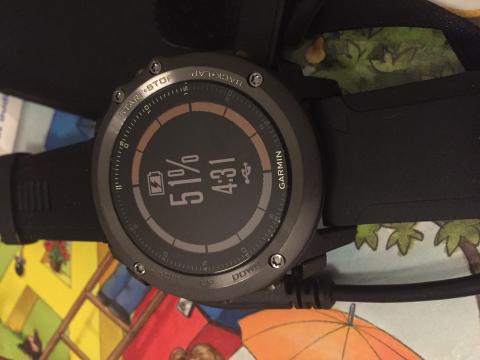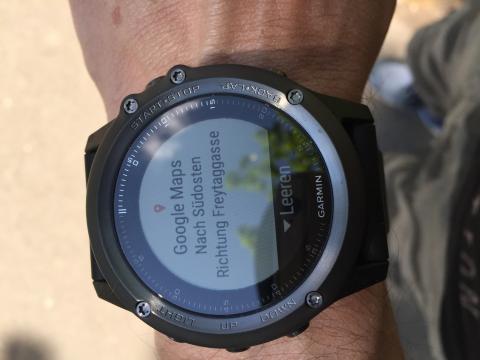Garmin Fenix 3 HR


Ich bin ja letztes Jahr von Garmin auf Suunto umgestiegen, weil mich der klassische Garmin GPS-Arm (während man auf ein Signal wartet) und ein paar Qualitätsprobleme störten. Es sollte eine Suunto Ambit 3 Sport werden, welche auch einen Mutli-Sport-Modus für Triathlon hatte. Die Garmin Fenix 3 hatte damals auch noch GPS Probleme und war viel teurer.
Die Suunto hat mich leider nie überzeugt, das GPS war zwar sofort da, die Movescount App ist super, aber die Uhr selbst war nicht mein Fall. Nachdem ich auch das Display kaum ablesen konnte, vorallem Abends beim Laufen und mir der Vibrations-Alarm vorallem bei Intervall-Trainings abging, habe ich meine Suunto schon letztes Jahr inseriert.
Als ich vor ein paar Wochen dann eine Bike-Runde drehte und wirklich gas gab um ein paar Strava Segemente meiner Kollegen zu knacken wollte mein Suunto das nicht mehr synchroniseren. Alle Tipps aus dem Internet halfen nichts und so kam es zu der Kurzschlußaktion - Preis wurde gesenkt und die Uhr noch am selben Wochenende verkauft.
Da stand ich nun ohne GPS Uhr und mit 2 Anmeldungen (Ring Attacke und WingsForLife). Was es werden wird, war vorher schon klar uns schon wurde die neue Garmin 3 HR bestellt. Die Neuheit hier ist das eine Handgelenks HR System hat und man so auch ohne Brustgurt immer den Puls aufzeichnet. 1 Woche später, genau am Tag vor der Ring Attacke kam das Schmuckstück dann.
Ich muss sagen, die Uhr übertrag alle Erwartungen. Endlich wieder meine 4 Datenfelder auf einen Blick (oder sogar noch viel mehr mit custom Apps). Vibrationsalarm funkt super, WLAN zum Synchen, was will man mehr.
Auch der erste Einsatz im Sport hat mich überzeugt. GPS ist schnell da, die Uhr zeichnet präzise auf und die Auswertungen übersteigen noch mein Wissen. Auch das Handgelenks HR haut sehr gut hin und ich habe es mehrmals mit anderen Systemen (Blutdruckmessgerät und co) verglichen.
Sobald ich alle Features im Griff habe, kommt ein detailliertere Post.
Der einzige Kritikpunkt ist die permanente Kopplung mit meinem iPhone was gut ist für die Notifications, aber sehr schlecht für den Akku.





Comments
ShaylaFkkbg (not verified)
Thu, 10/11/2018 - 23:00
Permalink
Revolutional package XEvil 4.0 recognize ANY hard captcha
Perfect update of captcha breaking software "XRumer 16.0 + XEvil 4.0":
captchas solving of Google (ReCaptcha-2 and ReCaptcha-3), Facebook, BitFinex, Bing, Hotmail, SolveMedia, Yandex,
and more than 8400 another types of captcha,
with highest precision (80..100%) and highest speed (100 img per second).
You can use XEvil 4.0 with any most popular SEO/SMM software: iMacros, XRumer, GSA SER, ZennoPoster, Srapebox, Senuke, and more than 100 of other programms.
Interested? There are a lot of impessive videos about XEvil in YouTube.
FREE DEMO AVAILABLE!
See you later ;)
Vida (not verified)
Tue, 06/21/2022 - 23:04
Permalink
Add new comment | Personal TriBlog
Football is the most famous disciplinein the world. Demand huge.
Millions of people watch matches of idols. Demand rising constantly.
Of course for the specified sport can make bets in a bookmaker's office.
Shortly tell history of football.
Development of discipline
Football originated in antiquity. Games with a ball in demand
among citizens of different countries. They were used in:
• Ancient China;
• Sparta;
• Ancient Rome.
Italians improved sport. During the Middle Ages they introduced to the world the game "Calcio".
With the development of trade relations, it came to England.
Love in sport formed instantly. By Popularity "Calcio" surpassed cricket.
First rules
Interest public appeared not by chance. Game impressed with its dynamics.
Passion on the field were serious. Such a scenario permitted norms of football:
1. 2 squads.
2. 25 athletes each.
3. 15 offensive players.
4. Right to fight.
Inhabitants of Foggy Albion made own rules. At first discipline wasn't standardized.
In some places allowed to throw ball with hands, in others
forbidden.
The first attempt to unification was made
in 1846. Conditions demanded momentary response. players from several
colleges entered the field on the field during the competition. Each
athlete acted in accordance with acceptednorms.
Result did not inspire positive development of events.
However, players were create a common regulations.
First standardization turned out positive. Participation public intensified.
According to the results in Great Britain formed the first specialized club.
Team named "Sheffield". It happened in 1857.
In 1863 appeared The Football Association of England.
Organization immediately created a single set of
rules of football.
Modern outline
Gradually discipline improved. Created requirements for the stadium.
Approved dimensions of the gate.
Important year became 1871. At that time originated the FA Cup.
Championship - oldest in the class.
1891 - year appearances in discipline kick from 11
meters. However, from modern this standard different. Now take penalties
from fixed spot. Earlier moment was done from the line.
Game evolved. Love grew. As a result in the 1880s, the
number of clubs passed over a hundred. In society began to arise speculations.
Some athletes felt that a number of rosters give players incentives.
At that time disciplines could be only amateur. As a
result rules changed. They added a clause prohibiting athletes
have a salary.
Began wave denunciations. Teams accused each other.
Some clubs left the championship. After time requirement
cancelled.
International development
Growth of trade accelerated penetration of discipline to Europe.
Following the results game became regulated at the supranational level.
FIFA appeared in 1904. At the start association included 7
countries.
Unified requirements clothing was. Football Players required to wear:
• headdress;
• shoes;
• elongated stockings;
• pants.
Normal established later. For the first time footballers played without license plates.
They appeared only in 1939.
Starting international tournament took place at the beginning of the last century.
Football included to the Olympiad. Participated total England, France,
Belgium.
The heyday of the sport occurred in the 1950. On the planet started playing high class stars.
Summer (not verified)
Thu, 07/07/2022 - 00:50
Permalink
Add new comment | Personal TriBlog
I have been browsing online more than 3 hours lately, yet I never found any interesting article like yours.
It is beautiful value sufficient for me. In my opinion, if all webmasters and
bloggers made excellent content material as you
probably did, the internet shall be a lot more useful than ever before.
Dwain (not verified)
Sat, 07/09/2022 - 00:00
Permalink
Add new comment | Personal TriBlog
Hi, I do think this is a great web site. I stumbledupon it ;) I am going to revisit once again since I saved as a
favorite it. Money and freedom is the greatest way to change, may you be rich and continue
to help others.
ShaylaRjxkj (not verified)
Fri, 10/12/2018 - 01:24
Permalink
New software XRumer 16.0 + XEvil solving ANY hard captcha
Incredible update of captchas solution software "XRumer 16.0 + XEvil 4.0":
captchas recognition of Google (ReCaptcha-2 and ReCaptcha-3), Facebook, BitFinex, Bing, Hotmail, SolveMedia, Yandex,
and more than 8400 another subtypes of captchas,
with highest precision (80..100%) and highest speed (100 img per second).
You can use XEvil 4.0 with any most popular SEO/SMM software: iMacros, XRumer, GSA SER, ZennoPoster, Srapebox, Senuke, and more than 100 of other programms.
Interested? You can find a lot of demo videos about XEvil in YouTube.
FREE DEMO AVAILABLE!
Good luck!
Add new comment